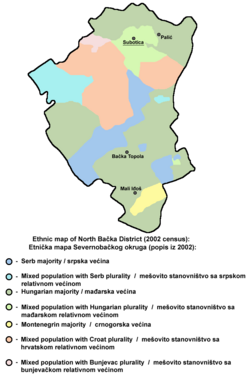North Bačka District
North Bačka District
Severnobački okrug Севернобачки округ Észak-bácskai körzet | ||
|---|---|---|
District of Serbia | ||
|
Images from the North Bačka District | ||
Municipalities 2 and 1 city | | |
| Settlements | 45 | |
| - Cities and towns | 3 | |
| - Villages | 42 | |
| Website | www | |


The North Bačka District (Serbian: Севернобачки округ, romanized: Severnobački okrug, pronounced [sêʋeːrnobâːtʃkiː ôkruːɡ]; Hungarian: Észak-bácskai körzet) is one of seven administrative districts of the autonomous province of Vojvodina, Serbia. It lies in the Bačka geographical region. According to the 2022 census results, it has a population of 160,163 inhabitants. The administrative center of the district is the city of Subotica.
Administrative history
In the 9th century, the area was ruled by the
During
During the royal
During the
Municipalities
The North Bačka District comprises three municipalities and 45 local communities. The municipalities are:
- Subotica (Hungarian: Szabadka)
- Bačka Topola (Hungarian: Topolya)
- Mali Iđoš (Hungarian: Kishegyes)
Demographics
| Year | Pop. | ±% |
|---|---|---|
| 1948 | 184,506 | — |
| 1953 | 186,569 | +1.1% |
| 1961 | 198,392 | +6.3% |
| 1971 | 205,929 | +3.8% |
| 1981 | 211,475 | +2.7% |
| 1991 | 205,401 | −2.9% |
| 2002 | 200,140 | −2.6% |
| 2011 | 186,906 | −6.6% |
| 2021 | 161,422 | −13.6% |
| Source: [1] | ||
According to the last official censuses done in 2011 and 2022, the North Bačka District had 186,906 and 160,163 inhabitants.
Ethnic groups
The population of the district is ethnically mixed.
| Ethnic group |
census 2011[2] | census 2022[3] | ||
|---|---|---|---|---|
| Number | % | Number | % | |
| Hungarians | 76,272 | 40.8 | 56,973 | 35.6 |
| Serbs | 50,472 | 27.0 | 48,672 | 30.4 |
| Croats | 5,937 | 3.18 | 10,646 | 6.65 |
| Bunjevci | 13,772 | 7.37 | 9,171 | 5.73 |
| Romani | 3,342 | 1.79 | 3,981 | 2.49 |
| Montenegrins | 3,654 | 1.95 | 2,241 | 1.40 |
| Yugoslavs | 3,426 | 1.83 | 2,450 | 1.53 |
| Total | 186,906 | 100% | 160,163 | 100% |
Languages
Languages spoken in the district (2022 census):
(*) Total number of speakers of South Slavic languages (Serbian and Croatian) that live in the district is 90,015 (56.20%).
Religion
Religion (2002 census):
- Roman Catholic= 117,456 (58.69%)
- Orthodox = 55,028 (27.50%)
- Protestant= 9,844 (4.92%)
- Other.
Municipalities and local communities
As of 2002, two municipalities have a Hungarian ethnic majority: Bačka Topola (58.94%) and Mali Iđoš (55.92%), while one municipality (Subotica) is ethnically mixed. The population of Subotica is composed of: Hungarians (38.47%), Serbs (24.14%), Croats (11.24%), Bunjevci (10.95%), Yugoslavs (5.76%), Montenegrins (1.25%), and others.
As for local communities, 20 have a Hungarian majority, 15 have a Serb majority, seven have Croatian/Bunjevci majority, one has a Montenegrin majority and two are ethnically mixed, with a Hungarian relative majority.
Culture
Subotica is a multi-ethnic and multi-religious center; in addition to the major
Economy
In keeping with its very rich resources, the region's food processing industry is well developed. The best examples are "29 November" meat industry, "Pionir" food factory and "Fidelinka" bread and flour products factory. Subotica ranks among the leading communities in Serbia when it comes to crop (maize, wheat and sunflower) yields.
See also
- Administrative divisions of Serbia
- Districts of Serbia
References
- ^ "2011 Census of Population, Households and Dwellings in the Republic of Serbia" (PDF). stat.gov.rs. Statistical Office of the Republic of Serbia. Retrieved 16 January 2017.
- ^ https://publikacije.stat.gov.rs/G2013/PdfE/G20134002.pdf
- ^ https://publikacije.stat.gov.rs/G2023/PdfE/G20234001.pdf
Note: All official material made by Government of Serbia is public by law. Information was taken from official website.
External links







